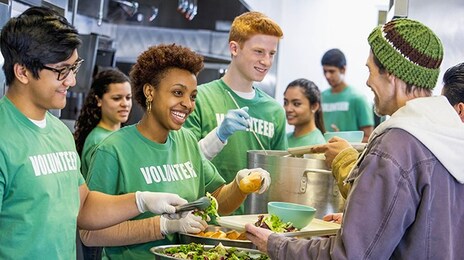|
Prior to COVID-19, volunteering was widely viewed as an international affair. Volunteers would travel overseas to developing countries to assist in instituting orphanages, schools, and other community projects. However, due to travel restrictions relative to the pandemic, numerous international volunteer opportunities were closed down. Volunteers who intended to embark on mission trips in the past year and a half were disappointed to find out that their plans had been cancelled. Those who were still interested in serving others sought out different ways to volunteer, and subsequently turned to local nonprofit organizations based right here in the United States of America. Although for many years, traveling abroad has dominated the narrative of volunteering, due to COVID-19 and limited travel, volunteers and nonprofits alike have had the opportunity to reap the benefits of “giving back” locally in the United States of America.
There are many upsides to volunteering locally versus internationally. Firstly, though it may seem fun to travel and see new countries, many who volunteer in developing nations are out of touch and disconnected from the community they are trying to help, as they are not knowledgeable on the community’s culture, language, and practices. On the other hand, those who volunteer locally feel more in tune with the members of the community and have a more familial relationship with other volunteers working in the nonprofit. Secondly, those who volunteer locally can donate more of their time to their service. Most international mission trips are not long-lasting opportunities, and a majority of them last between a few weeks to a month. In that short period of time, a volunteer is not able to maximize their service impact, and they also aren’t able to see the fruits of their efforts once they leave. However, when a volunteer commits to a local nonprofit organization, they can continuously see the positive effect their hard work and generous service has on the community, and that is far more rewarding. Lastly, there has been a lot of controversy swirling around the prospect of mission trips. Those who have conducted research on these international opportunities have found that, in most cases, the trips are more exploitative than altruistic. Volunteers are not given the proper orientation for the service they will be partaking in, and because of this, they are not able to provide the proper caliber of work for the developing community. Furthermore, many in the nonprofit community worry that these mission trips are perpetuating the ‘white savior’ complex. People travel to third and second world countries on the notion that they are changing the lives of those in these countries, and this mindset reinforces a notion that people in these areas of the world need saving from first-world liberators. However, by volunteering locally, volunteers can help people within their community whom they have a stronger connection to. There are over 3,000 nonprofits in the Triangle area that you can support. In the Durham-Chapel Hill area alone, there is a nonprofit for every 100 residents. After the pandemic, many of these organizations will be seeking service from those in the community. Now is the perfect time to make the commitment and help make your community a brighter place.
0 Comments
About Own Your Dream
In 2007, Laniesha Merritt combined her love of photography, event coordination, and music to create her first business, MyTru Productions. Three years later, using the profits from MyTru Productions, Merritt started the nonprofit Own Your Dream, an organization that produces talent and fashion shows for youth ages 6-17 years old. After working with the youth through this organization, Merritt soon realized that many lacked a safe space to talk about the obstacles and hard issues that life threw at them, which often held these young individuals back from chasing their dreams. To help the youth achieve their dreams, Merritt created the Dream Catchers program which works to create opportunities for those who need empowerment the most. In addition, Own Your Dream provides academic help such as tutoring, STEM programs, and homework assistance. They also provide outreach programs like Mind Over Melodies (teen summits), where they address problems such as drug use, sexual violence, gang involvement, and risk of HIV/STDs or unwanted pregnancies so that the youth have a comfortable and safe environment to discuss such topics. If you want to learn more about their outreach programs, click this link: https://www.ownyourdreamnc.org/materials-for-learning At Own Your Dream, Merritt has recruited people who experienced similar situations to the youth in this program, but went on to lead more successful lives. Dream Catchers The Dream Catchers program helps youth cultivate their interests in either cooking, photography, dance, production, or STEM. The courses are offered for six weeks, for two days each week for an hour. For each course, the youth learn all aspects of the subject and have a fun final project related to the field that they normally present to their friends and family. If you want to learn more about their Dream Catchers program, click this link: https://www.ownyourdreamnc.org/dream-catchers-program Volunteer Volunteers can help out with instructing the extra-curricular activities, such as fitness and cooking classes; help out with academic support such as tutoring, STEM based classes, or the Literacy program; serve in a clerical role; or provide photography and videography services. To volunteer, you must be at least fifteen years old. Volunteering at Own Your Dream is a great opportunity to help the youth in your community achieve their dreams. If you are interested in becoming a volunteer please contact Own Your Dream through this link: https://www.ownyourdreamnc.org/contact-us Employee volunteer programs have proven to be beneficial within companies. Studies have shown that these programs can increase job productivity, boost employee retention and recruitment, and improve workplace morale. Listed below are five key steps in creating an effective volunteer program within your company.
Step 1: Learn What Your Employees Want It is crucial to include your employees in the first steps of creating a volunteer program. Learn about the nonprofits they are interested in, if they currently volunteer, and the amount of time they are willing to dedicate to volunteering. Including your employees in the early stages will enable them to be more engaged in the program in the future. Step 2: Choose an Organization that Aligns with Your Company When choosing a nonprofit organization to partner with for your volunteer program, you want to choose an organization that aligns with your company’s values, skill sets, and business objectives. Step 3: Gain Support from Your Company’s Top Executives Gaining support from the top executives of your company is critical for the success of your volunteer program. This can be achieved through presenting the benefits of employee volunteer programs to them. Their support and engagement will serve as a guide for other employees. Step 4: Make Volunteering Beneficial Your employees will be less likely to volunteer if they receive no benefits. Some benefits that your company could offer are: paid volunteer time, public recognition through annual ceremonies, gift cards, certificates of appreciation, and more. Step 5: Track and Evaluate Your Progress Tracking the progress of your volunteer program is one way to determine its success. You should keep track of how many employees volunteer, the amount of time donated, the amount of money raised, the number of individuals served, the number of organizations served, and dollar value of the volunteers’ time. This will help you set and achieve future goals for your volunteer program, as well as show the impact of the volunteer program on the community. Social responsibility refers to the theory that all people are responsible for fulfilling their civic duty, and, when pertaining to businesses, this theory explains that companies must learn to balance economic advancement with awareness of social welfare. While some business owners might view this balance as a chore, businesses can actually benefit in numerous ways through social responsibility. Here are five main reasons why companies should consider incorporating corporate volunteerism into their organization.
Corporate volunteerism promotes a proper work/life balance for company workers. Companies that created volunteer programs for their workers noticed an increase in engagement, commitment, and efficiency in their employees, as well as an overall morale boost in the workplace. This is because the companies’ allotted volunteer time allowed for workers to form a balance between their work life and community service, which in turn made it easier for employees to find time to give back to the community. This balance works to reduce stress and even strengthen a worker’s loyalty to the company. When volunteering as a company, workers are given the chance to test and develop their leadership skills. Community service is the perfect environment for employees to share their valuable skills with each other in an area outside of the workplace. It gives workers the opportunity to display their adaptability, problem solving skills, and time management skills. On the same note, volunteering can be viewed as a team building activity; it allows for a company to work together towards a common goal of bettering the community. As employees reach this common goal of bettering the community as a whole, their self-esteem increases, as employees feel a sense of pride in the service they have completed, becoming more dedicated and enthusiastic individuals. By volunteering, a business can improve their reputation within a community. One of the most effective ways for a company to gain approval is to actively work to better its community. By proving that they are a trustworthy and devoted member of the community, a business will rally more support from their neighbors and peers. Greater social responsibility also leads to greater advocacy; members of the community will be more likely to advocate and sponsor a company that they know that they can depend on. Corporate volunteerism attracts more investors. Socially responsible companies attract more investment opportunities because they appear more honest and trustworthy than a business that doesn’t give back to their community. Investors are looking for companies with strong morals and an admirable cause, as well as a strong reputation. Plus, they are looking for versatile companies that can balance social responsibility with maximizing profit. Because of this, volunteering is a great way for companies to engage investors. Finally, corporate volunteerism works to build a stronger, more sustainable community. Because companies have more financial resources and able-bodied workers than most nonprofit groups, they are the most crucial in inciting change in their communities. Businesses have the ability to build a stronger community with benefits such as higher sustainability, a cleaner environment, and a more sturdy workforce. These advancements improve the livelihood of all people in the community, including the business itself. Because of all of these reasons, more companies have been forming volunteer programs to improve their social responsibility, and they have seen tremendous results and improvements. This proves that corporate volunteerism is highly effective and important for businesses to consider if they seek to improve and advance aspects of their company. About A Place at the Table
A Place at the Table aims to provide a sense of community and good food for all regardless of an individual’s monetary means. It is a pay-what-you-can café. This means that customers can pay the suggested price for their meal, less than the suggested price (as long as they pay at least $3), more than the suggested price, pay through volunteering, or pay using a Token from their community partners. You can pay it forward by tipping, paying more for your own meal, volunteering, or buying a $10 Token to hand out yourself in the community. Maggie Kane, who has a history of working at soup kitchens, conceptualized A Place at the Table in February of 2015 and opened it in January of 2018. Maggie wanted to create an inclusive and personal experience for all. She struggled with the experience associated with soup kitchens, as people aren’t able to choose their meals, can’t sit with others and share their meals, and have to rush to finish their meals due to time constraints If you want to learn more about Maggie Kane and the founding of A Place at the Table, watch her Ted Talk: https://www.ted.com/talks/maggie_kane_food_for_thought_choice_and_dignity Volunteering Due to COVID-19, A Place at the Table is not back to full capacity with volunteers, but they still provide many opportunities for volunteering. Recently, A Place at the Table welcomed back those who would like to “pay” for their meal through volunteering, as well as anyone interested in a weekly volunteer shift. They currently only offer Saturday and Sunday shifts and can have from 50-90 volunteers each day. You must be at least 15 years old to volunteer. At this time, groups are not able to be accommodated for volunteering. Volunteering at A Place at the Table offers a warm, friendly atmosphere and is an excellent opportunity to give back to your community. If you would like to learn more about A Place at the Table’s volunteer opportunities, click this link: https://tableraleigh.org/volunteer |
AuthorsJordan Hannan and Jordan Lappin Archives
January 2023
Categories |
Proudly powered by Weebly






 RSS Feed
RSS Feed